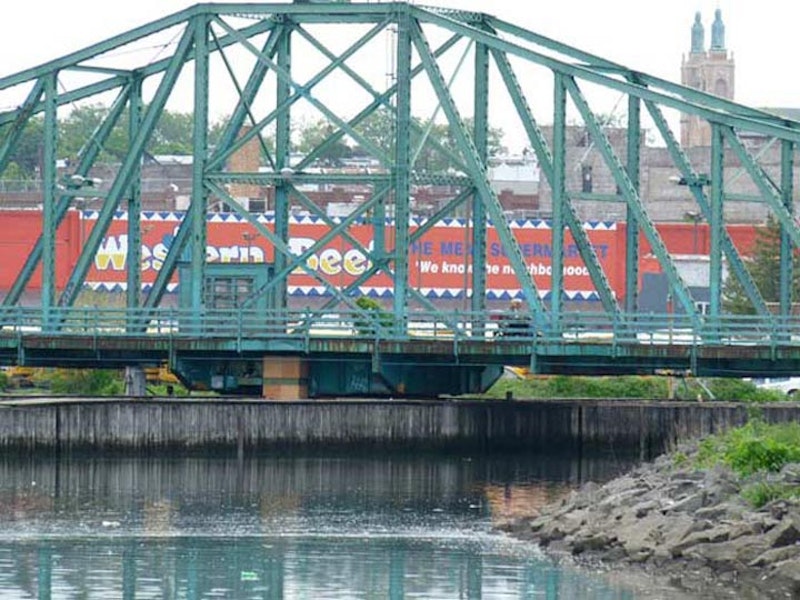Of the bridges that cross the noxious and noisome Newtown Creek, which includes the Pulaski (McGuiness Boulevard), J.J. Byrne (Greenpoint Ave.) Kosciuszko (Brooklyn-Queens Expressway), the Metropolitan Avenue Bridge, and the late lamented Vernon and Penny Bridges, my favorite is the rattling Grand Street Bridge, which connects remote sections of Brooklyn and Queens, two neighborhoods in East Williamsburg and western Maspeth you wouldn’t visit unless you worked there. Or unless you’re me.
The reason for my preference is simple. While the other Newtown Creek bridges are relatively bland products of the mid-to-late 20th century and boring, the Grand Street Bridge is a swing bridge, built in 1902, that looks like something you’d put together with an erector set when you were a kid.
It’s hard to choose what the best approach to the bridge is, esthetically speaking. You can approach by boat on Newtown Creek, as here. The twin spires of St. Aloysius Church, the tallest building in Ridgewood, are seen at right and can be seen from as far away as Sunnyside and Greenpoint.

But walking is the best way to cross it. You can hear the bmm of the cars and trucks as they run fast on the metallic-grated roadway, and feel the bridge moving up and down when an especially large truck rumbles over. You tread the thin slate sidewalk, likely not replaced since 1902, and stick the camera over the fence, knowing if you dropped it into the creek, it would begin to dissolve immediately. As would you, if you fell in the creek.

The Grand Street Bridge can swing 90 degrees to allow shipping on the creek to pass. Grand St. and Grand Ave., as the road is known in Queens, together are about 120 years old. Grand Ave. was engineered in the late-19th century as an eastern extension of Williamsburg’s Grand St., and was known as a Street in the early years of its existence before the Queens section became an Avenue, likely to differentiate it from Brooklyn. In Queens, the road’s eastern course overlapped the course of the Newtown Plank Rd., which is today’s Maspeth Ave. as far as its eastern junction with Grand and Flushing Aves. (Flushing Ave. itself is a straightened version of a colonial-era route called the Brooklyn and Newtown Turnpike.)

When necessary, traffic is given ample warning in the form of flashing lights positioned on both ends of the bridge and on the superstructure, while gates swing around to block traffic on both ends of the bridge. The Brooklyn-Queens line is in the center of the creek (which holds for the creek’s entire length). Occasionally the bridge will be left open for maintenance for a weekend, in which case traffic usually is diverted to the Metropolitan Avenue Newtown Creek bridge a short distance south.
The bridge passed its centennial with little fanfare in 2002 (it was opened in December 1902 or February 1903, depending on what source you use) and as old as it is, two previous bridges bridged the Newtown before it. The first, constructed in 1875, became dilapidated and wasn’t maintained (in a typical NYC and Brooklyn story) and was replaced in 1890, but was declared by the US War Department (now the Department of Defense) as a threat to navigation. Plans for a new bridge, the present one, were drawn up in 1898.

A shack used for bridge maintenance is still standing on the south side of the bridge. Looking through the dust- and graffiti-decorated glass, I discovered one of those battery-powered radios that also got TV reception. The last time I saw one of these in action in the 1970s, a lady at a lunch counter was using one to keep abreast of a soap opera story. I imagine Radio Shack still carries them, but as far as Shacks are concerned, Shake Shack is now clearly outdistancing Radio Shack.

In trolley news, there are lengthy sections of uncovered track on both sides of the bridge. The #59 trolley route plied Grand Ave. until December 12th, 1949. It’s been replaced by the Q59 bus, which runs from Kent Ave. in Williamsburg to Queens Blvd. near Queens Center in Rego Park. The depot, one of Queens’ busiest, sits just east of the Queens end of the bridge.
Preliminary work has begun on replacing this relic rattletrap, which is now approaching its 120th birthday, and the bridge will not likely see out the early part of this decade. I’ll miss it when it goes.
—Kevin Walsh is the webmaster of the award-winning website Forgotten NY, and the author of the books Forgotten New York (HarperCollins, 2006) and also, with the Greater Astoria Historical Society, Forgotten Queens (Arcadia, 2013)

